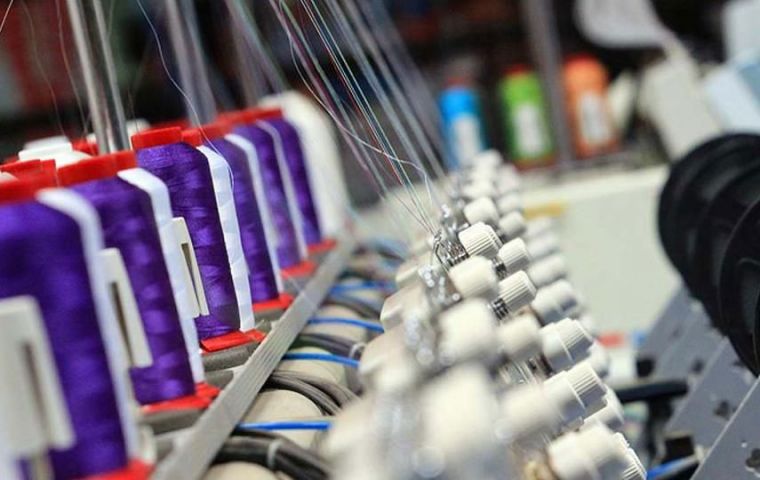MercoPress. South Atlantic News Agency
Argentina's industrial activity in September down 11.5% in the last twelve months
 Textile producers registered the biggest decline, down 24.6%, with printing down 21.6% and rubber and plastics production falling 20.4%
Textile producers registered the biggest decline, down 24.6%, with printing down 21.6% and rubber and plastics production falling 20.4%  The automobile industry saw a 15.7% slump, while the metallurgical sector plunged 20.5% and non metallic production, 3%
The automobile industry saw a 15.7% slump, while the metallurgical sector plunged 20.5% and non metallic production, 3%  Finally the food industry dropped 3.2%, mainly due to a 8.8% decline in grain and oilseed grinding.
Finally the food industry dropped 3.2%, mainly due to a 8.8% decline in grain and oilseed grinding. Argentine industrial activity plunged 11.5% year-on-year in September – the biggest drop in 16 years. The INDEC national statistics bureau said that manufacturing witnessed a fifth consecutive month of decline, following drops of 1.2% in May, 8.1% in June, 5.7% in July and 5.6% in August. It’s the biggest contraction since July 2002.
Increases were only registered by steel and aluminum producers, which recorded a rise of three percent, year on year. All the other sectors saw deeply negative figures, influenced by the drought, the drop in consumption, the high inflation and interest rates and the devaluation of the Argentine currency.
The figures came from INDEC’s Month Industrial Estimator (EMI), which shows that so far this year industrial activity has fallen by 2.1% in the first nine months of 2018.
Textile producers registered the biggest decline, down 24.6%, with printing down 21.6% and rubber and plastics production falling 20.4%. The automobile industry saw a 15.7% slump. The metallurgical sector plunged 20.5% and non metallic production, 3%. Finally the food industry dropped 3.2%, mainly due to a 8.8% decline in grain and oilseed grinding.
Construction activity also fell 4.2%, compared to the same month last year, the worst year-on-year decline since February, 2017. However, so far this year the sector as a whole has risen 6.4%, compared with the same period the previous year.
As part of the EMI report, INDEC asked industrial companies about their perspectives for the last quarter of the year and 60.7% said they expected a drop in domestic demand, while 30.5% the scenario will remain stable.
Meanwhile, 54.7% of those surveyed among exporting firms said they don’t expect major changes until December, while 28.6% said they expect an increase in the activity. Overall, 64.3% of the industrial companies said they don’t expect changes in their staff during the rest of the year, while almost 30% said they expect layoffs to occur in their companies.




Top Comments
Disclaimer & comment rules-

-

-

Read all commentsReekio,
Nov 13th, 2018 - 07:01 pm 0“Would the several commentators who joyfully commented about nearby stories about Argentina bother to say something about the results of the government they were so happy about some three years ago? They won't.”
I have already commented on this when you made a similar point in another thread. You have yet to respond there so I'll copy here for your convenience:
Again, you cherry-pick some data that supports your view but miss the wider picture.
1. Pretty much all economic activity is seasonal so comparing one month to another is meaningless;
2. When you look at the data for GDP from manufacturing you see the seasonal effect I mention in 1, but also the trend has been increasing for the last 2 years https://tradingeconomics.com/argentina/gdp-from-manufacturing; and
3. Industrial activity is just one component of the Argentine economy.
“Ideology is blind.”
Yours is blind to any good news from Argentina.
@ZB
Nov 13th, 2018 - 10:54 pm 01. The 11.5% fall was year-on-year, not compared to last month. It was also the biggest drop in 16 years, hardly something that could be explained by seasonal changes.
2. I don't know why those figures are different. Here's the Indec report the article is based on: https://www.indec.gov.ar/uploads/informesdeprensa/emi_11_18.pdf .
Maybe you can find some reasons for optimism in there.
3. Take a look at the overall GDP figures on the trading economics site if you want to know how the rest of the economy is doing.
REF: “industrial activity in September down 11.5%”:
Nov 14th, 2018 - 02:16 pm 0Pl. hold on. The govt. - as always & as the rest of the govts - will surely have perfectly reasonable justifications to explain their inefficiency and under-performance.
https://absurdamentes.files.wordpress.com/2014/01/charge-bbb.jpg?w=614
Commenting for this story is now closed.
If you have a Facebook account, become a fan and comment on our Facebook Page!